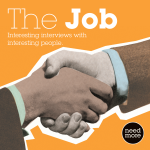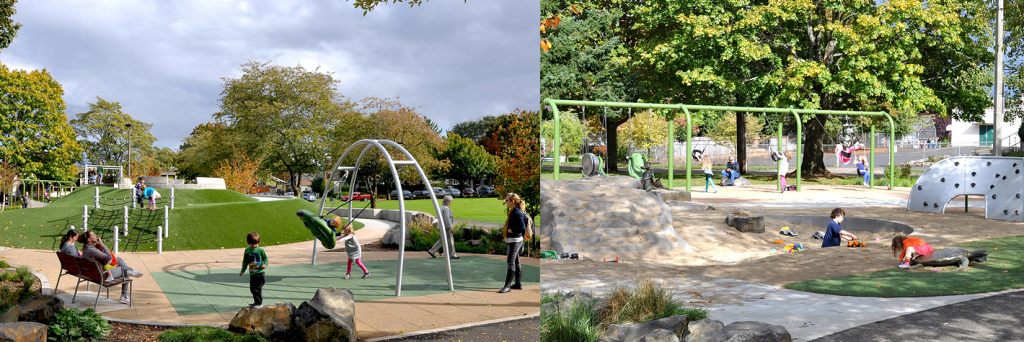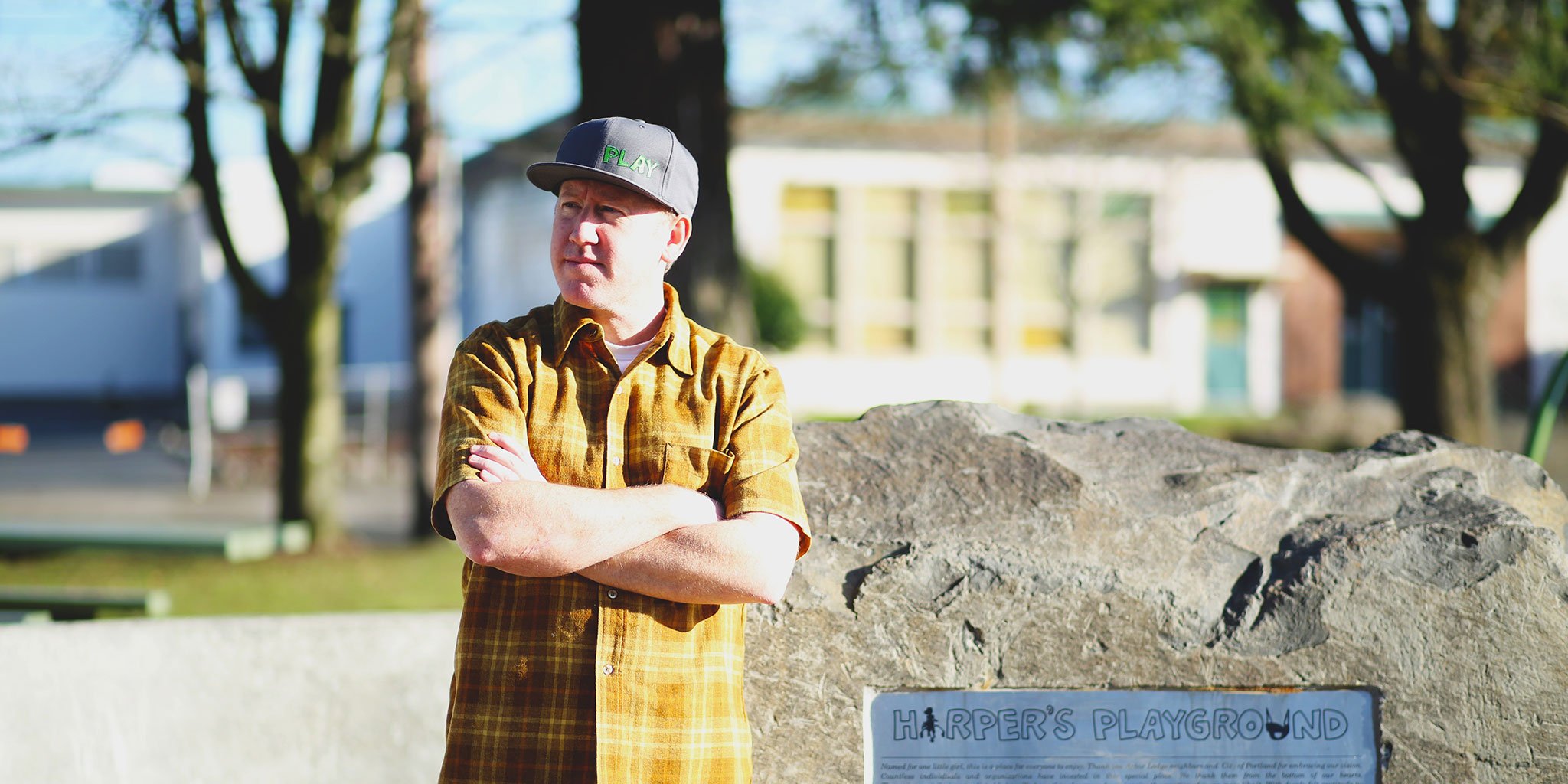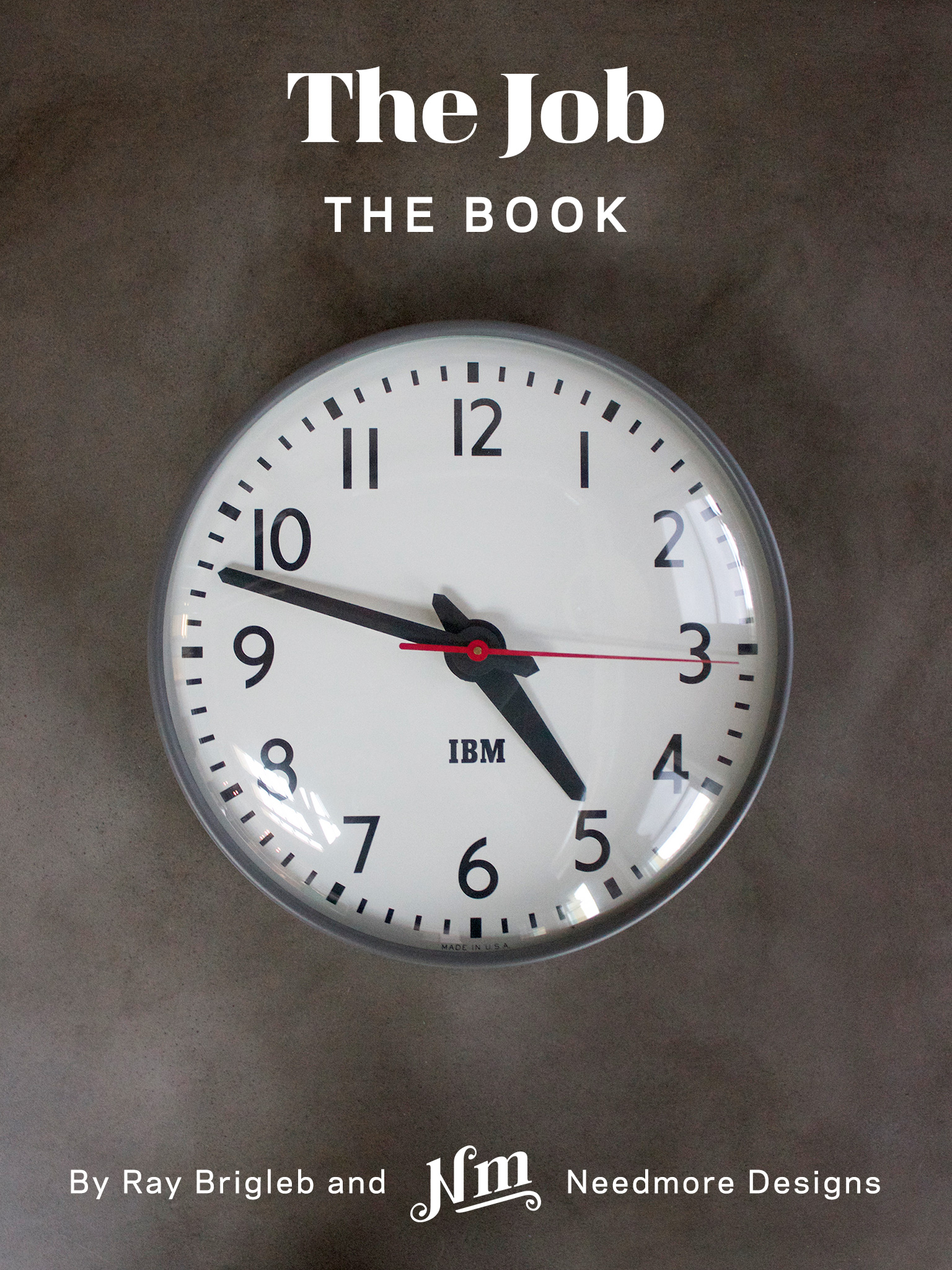
Cody Goldberg is the founder and Executive Director of Harper’s Playground, on a mission to make playgrounds more inclusive.
- The Iced Espresso recipe
- Harper’s Playground
- Cody speaks at TEDx Portland
- MIG
- Stone Soup
- Buckminster Fuller
- The Thoughtbot Playbook
The Interview
- Ray:
- Hi Cody. How are you doing?
- Cody:
- I’m doing well. Thanks for having me.
- Thank you for taking the time to come down to Needmore. I appreciate it. Why don’t we just start by telling me, are you from Portland? Is this your home town?
- I’m one of the many transplants from Northern California, but I believe I’ve qualified for my Oregon green card now that I’ve been here for almost 20 years.
- Oh sure, yeah. Before we talk about your current project, just give me a little background on what you did before this, where you’re coming from.
- I stumbled into a 15-year career and if I can do air quotes on the air here, air quotes around career and brand marketing. It certainly was accidental and never was the plan. I took a job in the mail room at Adidas’s America back in 1999, and that was by the sheer necessity of needing a job. Definitely gravitated towards sports marketing because that seemed the least amount of work and the most amount of fun. Then when I was recruited for a job in brand marketing with Red Bull energy drink a few years later, I definitely found an affinity for story-telling that is brand marketing and again, not being the sharpest tool in the shed, it seemed pretty straight forward. I understood what brand marketing was about.
I had about a 15-year career in brand marketing and that led perfectly into my new passion project, which is Harper’s playground, which I really launched as a brand being as that’s all I understood essentially from the standpoint of creating awareness and that’s all I understood from a standpoint of getting people to help you if they have something to get done, be it to sell a product or to sell an idea. It turned into a 1.2 million dollar special playground here in Portland, Oregon that took off to the extent that now it’s my full-time job.
 The growing Harper’s Playground brand. Harper’s Playground Website
The growing Harper’s Playground brand. Harper’s Playground Website
- How did you decide when the right time was to do that full-time?
- Who knows if it was right yet? I’m in the middle of it now, but I spent about a full year concentrating on creating the groundwork to make the leap and because we’re a non-profit, the primary focus of that time was spent on building an expanded and more professional board of directors than what we started with and that’s meant to be no slight on our original board, but those were neighbors we conned into coming to our house under the auspices of drinking beer and eating pizza with us, but then we told them you’re also our board of directors now. They performed admirably, but this is not just a more professional board, but it’s definitely expanded.
Having a board of directors to support your work is the groundwork that you really need to put in place, that and the strategic plan. We really spent a lot of the last year building the strategic plan that is a sustainable model to take this forward.
- To build other playgrounds and so forth?
- Correct.
- I’m actually curious before we go on, why is the board of directors so important to that type of work?
- That’s a perfect question. It’s two-fold. First and foremost, to be legitimate, you must have a board of directors. There is the oversight that a board offers you, and then there’s also the work. When you start out a nonprofit and you have no paid staff, the board does the work, and there’s a lot of work to be done, everything from the actual programming and strategic planning to the fund raising and development planning, to the oversight of the organization, which is doing an insurance package and as you can tell as the brand marketing guy, I don’t even want to talk about that stuff, but it’s all there. There’s all about paperwork.
- The board is pretty involved in what you’re doing it sounds like. They’re not just …
- Very much so, very much so. I think it’s a very standard way forward for starting nonprofits. You start with a working board. The board is heavily involved in doing the work and as you grow and you’re able to hire more staff, the board can pull back and spend more of it’s energies on the strategic plan and the oversight part of things.
- Just so our listeners can get up to speed, why don’t you tell me the story of your journey and how Harper’s Playground came to be?
- Harper’s Playground, I think like a lot of nonprofits started from a very simple necessity being seen that was not being met I guess. Our daughter, Harper, uses a walker to get around, and we noticed that when she made it in her walker to our neighborhood park, there was nothing for her to do there. A little research on-line, discovered that there were such things as accessible playgrounds, and we thought why shouldn’t our playground be accessible for our daughter, so we approached our neighborhood parks and rec department, asked them to build one, and they said there’s no money in the budget for such a thing, but if you’d like to go out and raise the money yourselves, we will allow you to do so. That is the genesis.
We started with a bake sale in front of our house and like I mentioned earlier, being in brand marketing I got into the business of creating a logo and a web site and all the other accoutrements of brand marketing, a flier, and all the rest, and just got busy. It was one of those things where the concept is so logical that play is so important for children, and children who experience disability need it even more so to help them catch up and to develop and to make the social connections that a playground offers, so it was always an easy sell. Playgrounds should be accessible for all. It being that it enveloped my whole being to a level that’s hard to describe, I just brought it up in every conversation for a few years and I reached out to everyone I’d ever met and asked them to help. It took off from there.
- In terms of time, how long was this from when you had this realization, this epiphany to when you broke ground on it?
- It was from first idea to the ribbon-cutting, it was three years. We’re approaching four years now since we started the idea. That’s a pretty fast timeline actually since the total amount we raised was 1.2 million dollars between cash and end-time services, but we’ve been at it four years in terms of focused energy and it feels like we’re at the right place to be launching it to bigger.
 Bake sales, meetings and huge support. Photo Credit Harper’s Playground Flickr
Bake sales, meetings and huge support. Photo Credit Harper’s Playground Flickr
- Was it hard doing this while having a full-time job, pulling this together?
- Definitely time management was a key focus of my energies and marrying a woman who is extremely forgiving was a key part of our success. She allowed me to really put a lot of time into this. It was pretty much every weekend, every lunch hour, and many evenings spent. It was a lot of meetings, a lot of courting meetings and especially large fund raising events. We grew from doing the very simply bake sale in front of our house to the large gala. Those large galas were a seated meal and auction items and all that business. It’s a ton of coordinating, ton of meetings. To answer your question though, yeah, it was challenging to balance having a job and having another job.
- Is this type of playground, I’ve got to admit, it seems like a great idea and a necessity and obvious thing really, to say that all kids should be able to play in a playground. Is it something that exists elsewhere outside of Portland? Is there anything that comes close in Portland in the past?
- There are in just the Portland metro, Portland Parks and Rec District, Portland Metro is beyond that, but in Portland, the City of Portland has 110 playgrounds. This is the only one that is universally accessible, 100%. The one that’s closest was built about 16 years ago. It was fully funded by the Rotary of Portland. Portland Parks and Rec estimates that they can call it 70% accessible, so there’s definitely a big need to change that model for sure. Around the country, there are some other examples of things that are somewhat similar. I think what we really embrace and what sets Harper’s Playground apart from almost all of the rest is that we 100% went away from any sort of structure on site. It’s completely a play plaza.
That’s really because we found that no matter how you try to adapt the structure with some sort of ramp system, it segregates people who use wheels and forces them to a different route, so we eliminate the structure altogether and create this play plaza, and that design concept was really pioneered by an outfit called MIG out of Berkley, California. It has existed before that in terms of artists who have created parks in the past. The 60s and 70s saw some really beautiful playgrounds around the world that I think it was actually almost by happenstance that some of them were university accessible. That’s just because they were the vision of an artist who put them together and the entire playground industry in the late 70s, early 80s started really moving towards these pre-manufactured structures that are not only inaccessible, but are uninspiring and really kids have shown they don’t really like them that much.
- I very much agree with you. I think you probably wrote the copy on the web site that points out that some of the accessible playgrounds, if I can quote you here, look about as fun as a TSA line at the airport. I would agree with it. That video on your web site is very inspirational and brought together a lot of very recognizable voices in Portland. How did you get that together and how important do you think having that video to introduce people to what you’re doing, how important do you think that is?
- The video was produced by a local outfit called Actual Industries, and they embraced our project early on. They had done a project with Timbers Army called Art Takeover, and it was a fund raiser that the Timbers Army and Actual Industries and another local outfit called Factory North all put together. The video is pretty recent actually. Actual Industries was kind enough to take a lot of the old footage that we had been collecting. They shot new interviews and put together that nice piece for us. We had two main missions for that video. We wanted to use it as a thank you to everyone who helped us, to be able to share with all of these people who put so much time and energy into the project to say thanks and here’s a cool video that celebrates you, but we also had a dual purpose for the video and we did want it to help tell the story and attract more people to the whole concept.
It’s definitely been I think successful at doing both of those things. Having a background in film, it was fun to work with some professionals in that for sure. I think I might have forgotten part of that question. I think sometimes I get to talking and then it’s all over the shop.
- No, we’re going to go all over the place here. That’s great. I actually found a lot of stuff that I enjoyed reading on your web site. I also wanted to ask you about, there’s a section on your site where you talk about the solution to this problem with a playground use for everyone and access, and you quoted R. Buckminster Fuller. Are you a fan?
- Huge, huge fan.
- How does his work inspire what you’re doing?
- I found out a lot about myself in this process, there’s no doubt, and I think I found out that I love design and I especially love the great designer for the reason that I think is why a lot of us are attracted to them. They are usually cutting through the clutter of over-thoughtfulness and getting actually to the heart of things, which is simplicity. I think R. Buckminster Fuller, I also am a big fan of Frank Lloyd Wright. I find their design philosophy and what they accomplished to be simplification of things and really considering the user and the user experience all the way. Buckminster Fuller, I just also love what he said. The one I really love probably the most, he said, “I never set out to create something beautiful, but if the solution I come up with isn’t beautiful, then I know it’s wrong.” I really like that.
He’s really speaking about the function is everything, but if it’s not beautiful, then you know that it’s not right. I think for a playground, that’s especially important. Beauty, I talked about this recently in another talk about the science behind our reaction to beauty and how uplifting that is, so I always knew the playground had to be beautiful. The overall aesthetic had to be beautiful. That’s in large part because now it’s bears my daughter’s name, and she’s pretty beautiful.
- Where do you see, now that you’re doing this full-time, you’re in it now, what is your goal?
- My very simple goal is to work myself out of a job and to have the Harper’s Playground literally become the new model of all playgrounds such that I’m no longer necessary. I’m on a mission to change every playground in the world.
 Harper’s Playground. Photo Credit Place Studio
Harper’s Playground. Photo Credit Place Studio
- I like it. What do you see being the next step? Are you thinking about another location in Portland or do you have any plans you can talk about now for that?
- Yeah. Really it’s two-fold. We plan to engage as the lead agency in transforming some playground projects here in Portland, Oregon. Our vision is for four more in the City of Portland by the year 2020 and there’s sort of a ready-made reason for that. Portland Parks and Recreation has what’s called a Vision 20/20 plan that they created about I think the middle of the 90s or maybe early 2000s. We just want to dovetail into their plan and help them realize their vision and also just it sounds like a good catchy title for a vision plan and that’s why they named it 20/20, clear vision. Four more in Portland because there are officially five quadrants in Portland.
We built the first Harper’s Playground in the fifth quadrant North Portland, so each other quadrant we think should get one. That’s also a nice clear way to have an equal distribution of these vital amenities throughout the city spread equally. Concurrently we’re working on a model where we act as a consulting group for other municipalities and help them realize a Harper’s Playground with our support. What’s nice about that is we don’t do all of the heavy lifting ourselves to raise the funds to do the project. We will come in and help others do it, and that should help us with not only being a sustainable model, but a more impactful model in a shorter time frame I think. Like I said, I’m not the sharpest tool in the shed, but I just try to keep it simple.
- If there was someone else who had a passion project in mind like you, felt really strongly about wanting to change something that’s just driving them crazy that affects them personally, what is the key to doing something grass roots like this? Do you need a marketing background? Do you need to know the city council members? What is the secret there?
- This is a great question. This is a fascinating one that I’ll try to work my way through here in answering it. I think ultimately what you need is persistence, a dogged persistence to see your vision come to be and in the earliest stages, you need to convince people whether it’s true or not that you have that. I think the process of convincing people that you’re not going to give up, that it’s going to happen, then they actually will start to join and help because they do believe you. I do remember in the earliest stages I did believe it was going to happen, and I would tell people about that belief, and then they would start to help. Then the next thing you knew, you had an army of people helping, and then it started to transform.
I think actually the answer is the stone soup model of how you accomplish anything. I think the book, The Stone Soup, the old story is sort of how most everything gets done in essence. Even if it’s a project with a big budget and the money is already there, you still have to attract people to get involved and help.
Before people will really give of themselves to something, they have to see that the vision is clear and it’s going to happen. Whether it’s grassroots or building a dam that’s again fully funded, the key player involved has to definitely see it through and see it’s going to happen. There’s a long-winded answer to just saying persistence, ultimately.
- How has this project changed you? How was Cody different five years ago from now?
- Man, it’s hard to remember the Cody then to a certain degree. I think he must have been a little bit lost or he just wasn’t quite, I don’t think I’ve ever spoken about myself in the third person like that. I wasn’t sure exactly what my dream was in life. I think something I’ve been looking for since I was a little kid, dream/mission. What am I here to do? I’m different now because I found it. This is definitely what I was put on this earth to do, was to build these playgrounds. It took my daughter coming into my life to show that to me. It was never right before then, but it’s right now. All of my experiences before Harper coming into my life led to this place.
I think that’s also why I was able to convince people it was going to happen. I knew in every cell of my body that this is what I should be doing. That’s why doing an all nighter to do a grant application never felt tedious to me. It felt I was doing what I was supposed to be doing. It was leading us to the next stage, which was to complete this project that I believed in so wholeheartedly. The cliques that when you find work that you love, it’s not work. I’ve changed because I’ve found my special purpose, just like Steve Martin in The Jerk.
- I was going to say like quote from The Jerk. On that note, Cody, thank you so much for coming down and talking to me today.
- Awesome. My pleasure. I think we’ve ended on the perfect quote for the show.
- Light-hearted note, excellent.
- Thanks for having me.

